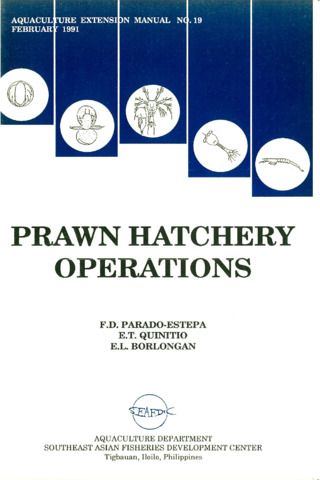Prevalence of yellow head virus in cultured black tiger shrimp (Penaeus monodon Fabricius) from selected shrimp farms in the Philippines
| dc.contributor.author | Natividad, Karlo Dante T. | |
| dc.contributor.author | Magbanua, Fe O. | |
| dc.contributor.author | Migo, Veronica P. | |
| dc.contributor.author | Alfafara, Catalino G. | |
| dc.contributor.author | Albaladejo, Juan D. | |
| dc.contributor.author | Nadala, Jr., Elpidio Cesar B. | |
| dc.contributor.author | Loh, Philip C. | |
| dc.contributor.author | Tapay, Lourdes M. | |
| dc.contributor.editor | Lavilla-Pitogo, Celia R. | |
| dc.contributor.editor | Cruz-Lacierda, Erlinda R. | |
| dc.date.accessioned | 2021-10-15T07:51:56Z | |
| dc.date.available | 2021-10-15T07:51:56Z | |
| dc.date.issued | 2002 | |
| dc.identifier.citation | Natividad, K. D. T., Magbanua, F. O., Migo, V. P., Alfafara, C. G., Albaladejo, J. D., Nadala, Jr., E. C. B., Loh, P. C., & Tapay, L. M. (2002). Prevalence of yellow head virus in cultured black tiger shrimp (Penaeus monodon Fabricius) from selected shrimp farms in the Philippines. In C. R. Lavilla-Pitogo & E. R. Cruz-Lacierda (Eds.), Diseases in Asian aquaculture IV: Proceedings of the Fourth Symposium on Diseases in Asian Aquaculture, 22-26 November 1999, Cebu City, Philippines (pp. 45-55). Fish Health Section, Asian Fisheries Society. | en |
| dc.identifier.isbn | 9718020160 | |
| dc.identifier.uri | http://hdl.handle.net/10862/6195 | |
| dc.description.abstract | The prevalence and geographic distribution of Yellow head virus (YHV) in cultured Penaeus monodon in the Philippines was documented by Western blot assay. Fifty-three out of 219 samples (24.2%) were found to be positive for YHV infection. Among the ten provincial sampling sites, selected shrimp farms from Misamis Occidental had the highest prevalence of infection with 66.7% followed by South Cotabato, Negros Occidental and Capiz with 43.7%, 35.4% and 33.3% respectively. Selected shrimp farms in Agusan del Norte and Bohol were also positive for YHV infection at lower prevalence. Samples from Bataan, Batangas, Cebu and Misamis Oriental were all negative for YHV infection. The prevalence of YHV in the different life stages of shrimp was also determined. Post larval stage had the highest prevalence of infection with 54.5% followed by the juvenile stage with 40.8% and adult stage with 16.9%. Infectivity studies resulted to 60% cumulative mortality 17 days post-infection in juvenile shrimp and 50% cumulative mortality 19 days postinfection in adult shrimp. YHV infection was further confirmed by electron microscopical examination, histopathological examination and in vitro infectivity assay. | en |
| dc.publisher | Fish Health Section, Asian Fisheries Society | en |
| dc.subject | prawns and shrimps | en |
| dc.subject | Penaeus monodon | en |
| dc.subject | pathogenicity | en |
| dc.subject | Philippines | en |
| dc.title | Prevalence of yellow head virus in cultured black tiger shrimp (Penaeus monodon Fabricius) from selected shrimp farms in the Philippines | en |
| dc.type | Conference paper | en |
| dc.citation.spage | 45 | en |
| dc.citation.epage | 55 | en |
| dc.citation.conferenceTitle | Diseases in Asian aquaculture IV: Proceedings of the Fourth Symposium on Diseases in Asian Aquaculture, 22-26 November 1999, Cebu City, Philippines | en |
| dc.subject.asfa | animal diseases | en |
| dc.subject.asfa | shrimp culture | en |
| dc.subject.asfa | viruses | en |
| dc.subject.asfa | electron microscopy | en |
| dc.subject.asfa | histopathology | en |
| dc.subject.asfa | cell culture | en |
| dc.subject.scientificName | Penaeus monodon | en |
Files in this item
| Files | Size | Format | View |
|---|---|---|---|
|
There are no files associated with this item. |
|||
This item appears in the following Collection(s)
-
Diseases in Asian aquaculture IV [43]
Proceedings of the Fourth Symposium on Diseases in Asian Aquaculture, 22-26 November 1999, Cebu City, Philippines




